Now that you’ve had a chance to peruse the rules, you’re ready to start unleashing carnage upon the battlefield. That being the case, it’s time to gather together an army that will win you glory on the field of war. Each player in a Warhammer 40,000 battle commands an army. An army is a collection of one or more units of Citadel miniatures, and can consist of any number of models. Before any game, players must agree how they are going to select their armies, and if any restrictions apply to the number and type of models they can use. If you are using a Warhammer 40,000 mission, it may tell you how to select your army. If you are not using a mission, then you must decide what method of army selection each of you will use for yourselves. The rules for your Citadel miniatures are found in a wide range of Games Workshop publications, such as codexes, codex supplements and dataslates. Regardless of where this information is found, it is known as an Army List Entry. Each Army List Entry describes a unit of Citadel miniatures and includes everything you will need to know in order to use that unit in a game of Warhammer 40,000. In some older codexes, the information for a single unit’s Army List Entry is spread out amongst different sections of the book. Taken together they describe, and are treated for all rules purposes as, a single Army List Entry. When using such a codex, each unit’s Faction is the same as its codex title. For example, all units in Codex: Space Marines belong to the Space Marines Faction, whilst all units in Codex: Chaos Daemons belong to the Chaos Daemons Faction. There are many ways to choose an army, and they all have their strengths. The first thing to determine is whether or not you and your opponent will be using points limits, and if so, what they are. Usually, both players will use the same points limit, but this does not need to be the case and is entirely up to you. To use points limits, you will need to reference each unit’s points value, which you can find in its Army List Entry. Simply add up the points values of all the units in your army, and make sure that the total does not exceed the limit agreed upon for the game. It is worth noting that games with larger points limits, say 2000-3000 points, can take the better part of an afternoon to play, while games of 1000-1500 points can usually be completed in a few hours. Whether or not you decide to use points limits, the next step is to choose how your army is organised. The two main ways of organising an army are the Unbound method and the Battle-forged method. Both players need not use the same method. There are many other types of restrictions and requirements that players might agree on for their armies. Requiring certain units or named characters to be present in your game, for example, is a great way to add a narrative for your battle. Every army has a Primary Detachment. If you organise your army using the Battle-forged method, whichever Detachment contains your Warlord is your Primary Detachment. If you used the Unbound method, then once you choose your Warlord, every model in your army that has the same Faction as your Warlord is considered to be part of the Primary Detachment for all rules purposes. Of course, in an Unbound army, these models are not bound by any Detachment restrictions and do not receive Command Benefits. For example, Jon uses the Unbound method to organise his army of Citadel miniatures. He chooses some of them from Codex: Space Marines and some from Codex: Tau Empire. Jon picks Kor’sarro Khan as his Warlord, who belongs to the Space Marines Faction. Therefore, all of the units he chose from Codex: Space Marines act as his Primary Detachment for the duration of the game. Write down the details of the models that make up your army, which units belong to which Detachments, which Detachment is your Primary Detachment, and which model is the army’s Warlord. This written record is known as your army’s force roster, and you must keep it to hand while you play the game. To keep things fair, you must always allow your opponent to read your force roster before a game if they wish to do so. Some models are noted as being Unique in their Army List Entry. Unique models include named characters and extraordinary units or vehicles, of which there is only one known example in the whole galaxy. Because of this, you can only ever include one of each Unique model in an army. Armies are usually structured organisations; even the Orks organise their warriors into mobs and warbands, though perhaps not with quite the same vigour as the Astra Militarum organises its squads, platoons, companies and regiments. As discussed above, there are many ways to forge a collection of Citadel miniatures into an army ready to crush your enemies in games of Warhammer 40,000. This section focuses on the Battle-forged method. If you opt to choose an army using this method, your units are organised into Detachments and many gain special rules and in-game advantages. We have included two Detachments at the end of this rules section, each with its own Force Organisation Chart, Restrictions and Command Benefits. You will find further Detachments to use in your games of Warhammer 40,000 in our codexes and other Games Workshop publications. There is no limit to the number of Detachments a Battle-forged army can include and you can use any mixture of Detachments you have available, within the restrictions of the rules that follow. However, all of the units in your army must belong to a Detachment and no unit can belong to more than one Detachment. If you choose to use a Battle-forged army, you must tell your opponent what units belong to what Detachments and what Command Benefits each will receive (if any) before you start deploying your army. Don’t forget that Detachments are entirely optional and you can still select an army by taking any models from your collection, as discussed in the Unbound method – it just means that none of the models in your army receive Command Benefits. In order to organise their army into Detachments, a player will often need to use additional information found in their units’ Army List Entries, such as Faction and Battlefield Role. All units belong to one of the many Factions that are fighting in the 41st Millennium. This will often be represented on the unit’s Army List Entry with a symbol, the key for which can be found to the right. A unit’s Faction applies regardless of how you choose your army, but is especially relevant to Detachments because many state that you can only include units of a particular Faction. Factions are also used when including Allies, and some special rules will apply only to specific Factions. Note that Fortifications are an exception in that, unless otherwise stated on their datasheet, they do not have a Faction. In the case of older publications, the Faction of all the units described in a codex is the same as the codex’s title. In the case of codex supplements, the Faction of all the units described in that publication is the same as the codex it is a supplement of. There are a few units whose Army List Entries are presented in more than one Games Workshop publication. Daemon Princes, for example, are presented in both Codex: Chaos Daemons and Codex: Chaos Space Marines. In these instances, the unit’s Faction is determined by whichever codex it was chosen from. Be sure to keep track of which is which if you decide to take one from more than one source. 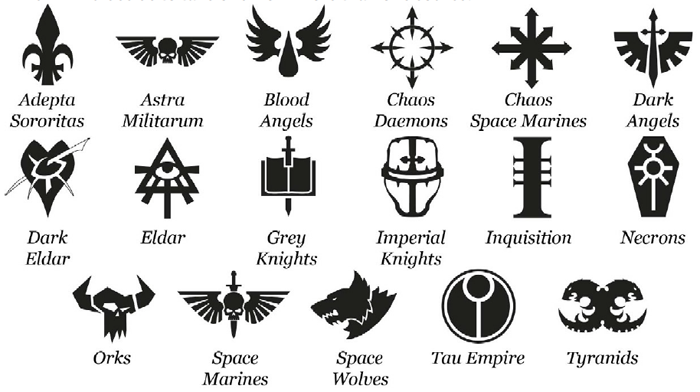         Certain rules can alter a unit’s Battlefield Role, changing it, for example, from a Fast Attack unit to a Troops unit. If a unit changes its Battlefield Role due to such a rule, it maintains its new role for the entirety of the game. Other rules will state that a unit or Army List Entry can be taken in more than one Battlefield Role (for example, a unit can be taken as either an Elites choice or a Heavy Support choice). Whichever Battlefield Role the unit is taken for, it will maintain that role for the entirety of the game. If you have several such units in your force, be sure to keep track of which role was chosen for each one. You can include any number and type of Detachments in a Battle-forged army provided you have sufficient units. Simply select a type of Detachment and organise some or all of your units so that they fit within the restrictions and limitations detailed on that particular Detachment. Later in this section you will find the Combined Arms Detachment and the Allied Detachment. Both of these can be used with any army. Each Detachment is split into three sections: Force Organisation Chart, Restrictions and Command Benefits. 1) Force Organisation Chart. This shows the number of units of each battlefield role that you may include in this Detachment. Black boxes are choices you must include to take this Detachment, whilst grey boxes are optional choices. 2) Restrictions. This lists any restrictions that apply to the types of units you may include in this Detachment. 3) Command Benefits. This lists any additional bonuses or special rules that apply to some, or all, of the units in this Detachment. 1) FORCE ORGANISATION CHART 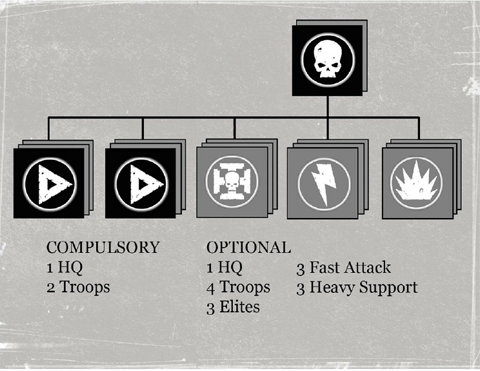 2) RESTRICTIONS All units chosen must have the same Faction (or have no Faction). 3) COMMAND BENEFITS Ideal Mission Commander: If this Detachment is chosen as your Primary Detachment, you can choose to re-roll the result on the Warlord Trait table. This section of the Detachment lists the minimum and maximum number of units of each type that you must or may include in the Detachment. The boxes on a Force Organisation Chart are referred to as slots. Each slot will typically specify a Battlefield Role. Each slot allows you to take one unit. Black boxes are compulsory selections – you must take at least this many units of the appropriate Battlefield Role to include this Detachment in your army. If you cannot include the compulsory number of units, you cannot include that Detachment. Grey boxes are optional selections – you can include up to this number of units of the appropriate Battlefield Role when including this Detachment in your army. Any further units of the same Battlefield Role will need to be taken in a different Detachment. For example, in order to take a Combined Arms Detachment, you must select two units with the Troops Battlefield Role, and cannot select more than six in the same Detachment. Occasionally, a Force Organisation slot will not specify a Battlefield Role, in which case any type of unit can be taken, or it will specify a particular unit or units, in which case only those particular units may (or must) be taken. For example, a Rhino bought for a Space Marine Tactical Squad (Troops) counts as a unit of Troops, but one bought for a Space Marine Sternguard Veteran Squad (Elites) counts as Elites. Other vehicles may also have a Transport Capacity, but as they are chosen separately, they have a Battlefield Role and occupy a Force Organisation Chart slot of their own. More information about Dedicated Transports can be found in the Vehicles section. This section of the Detachment lists any additional restrictions that apply to the units you can include as part of this Detachment. If an Army List Entry does not adhere to a particular restriction, it cannot be included as part of this particular Detachment. For example, in order to include a Combined Arms Detachment, all of its Army List Entries must have the same Faction. If a Detachment does not list any Restrictions then it has none. This section of the Detachment lists any special rules or benefits that apply to some or all of the models in that Detachment. For example, the units in a Combined Arms Detachment benefit from the Ideal Mission Commander and Objective Secured special rules. If a Detachment or Force Organisation Chart does not list any Command Benefits then the units that make it up receive no additional benefits. Formations are a special type of Detachment, each a specific grouping of units renowned for their effectiveness on the battlefields of the 41st Millennium. Whilst some Formations provide you with all the gaming information you will need to use them in your games, it is not uncommon for them simply to describe a number of special rules that apply when you include several specific units together. Instead of including a Force Organisation chart, the Army List Entries that comprise a Formation are listed on it, along with any special rules that those units gain. Unless stated otherwise, each individual unit maintains its normal Battlefield Role when taken as part of a Formation. Unlike other Detachments, Formations can also be taken as part of Unbound armies. If they are, their units maintain the special rules gained for being part of the Formation. The following Detachments can be included in any Battle-forged army. 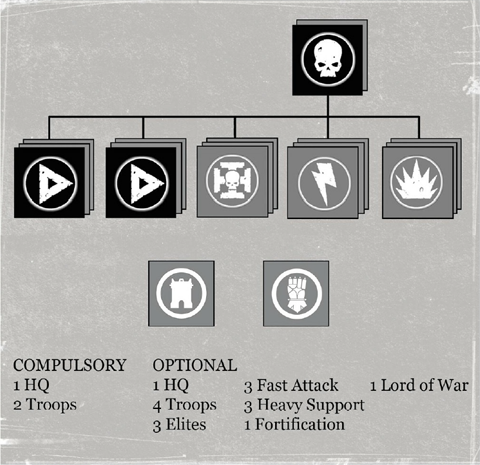 All units chosen must have the same Faction (or have no Faction). COMMAND BENEFITS Ideal Mission Commander: If this Detachment is your Primary Detachment, you can choose to re-roll the result when rolling on the Warlord Traits table. 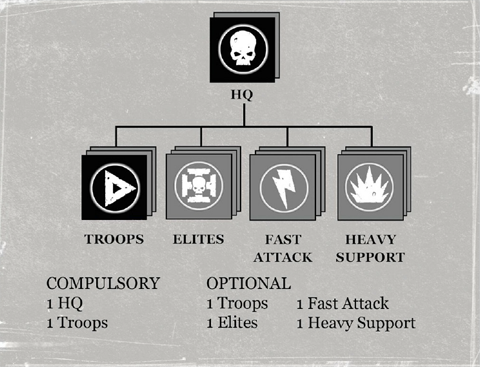 This Detachment cannot be your Primary Detachment. Your Warlord can never be chosen from this Detachment. All units chosen must have the same Faction (or no Faction). All units chosen must have a different Faction to any of the units in your Primary Detachment (or no Faction). COMMAND BENEFITS Objective Secured: All Troops units from this Detachment have the Objective Secured special rule. A unit with this special rule controls objectives even if an enemy scoring unit is within range of the objective marker, unless the enemy unit also has this special rule. Unforeseen alliances happen all the time in the murky world of Warhammer 40,000. The Eldar might assist the Astra Militarum in destroying a Tyranid invasion, knowing that if they don’t, the forces of the Hive Mind will destroy a craftworld. A Tau commander might hire Orks of the Blood Axe clan, little realising that his Chaos Space Marine enemies have already struck a similar arrangement with the selfsame greenskins. You can include models from any number of different Factions in the same army if you wish. Irrespective of the method you use to choose your army, this section tells you how models from different Factions fight alongside each other. To represent this, we have several categories of alliances, each of which imposes certain effects on the game. The Allies Matrix below shows the levels of alliance between units that have different Factions in the same army. 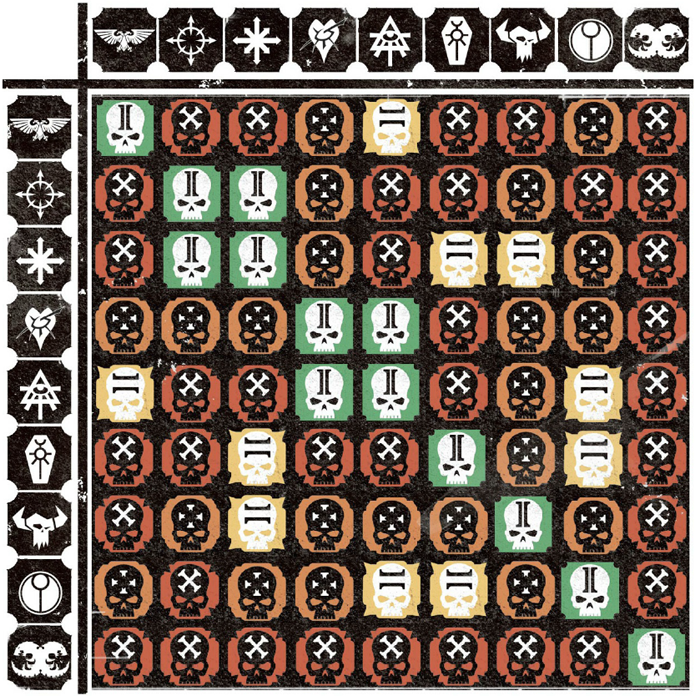 
 In some rules presented in Games Workshop publications the term Aeldari is used. This simply means Eldar, Dark Eldar, Harlequins or Ynnari. For example, if a special rule refers to ‘any Aeldari model’, it means ‘any model with the Eldar, Dark Eldar, Harlequins or Ynnari Faction’. In some rules presented in Games Workshop publications the term Aeldari is used. This simply means Eldar, Dark Eldar, Harlequins or Ynnari. For example, if a special rule refers to ‘any Aeldari model’, it means ‘any model with the Eldar, Dark Eldar, Harlequins or Ynnari Faction’.
One Eye Open: At the start of each of your Movement phases, each unit within 6" of a Desperate Allies unit must roll a D6 – on a roll of a 1, that unit cannot move, manifest psychic powers, shoot, run or charge that turn (they’re too busy watching for betrayal). Zooming Flyers and Swooping Flying Monstrous Creatures may not pivot and must instead move the minimum distance required (18" and 12" respectively). FAQArmy Lists
Detachments & Formations
|
The Rules >


